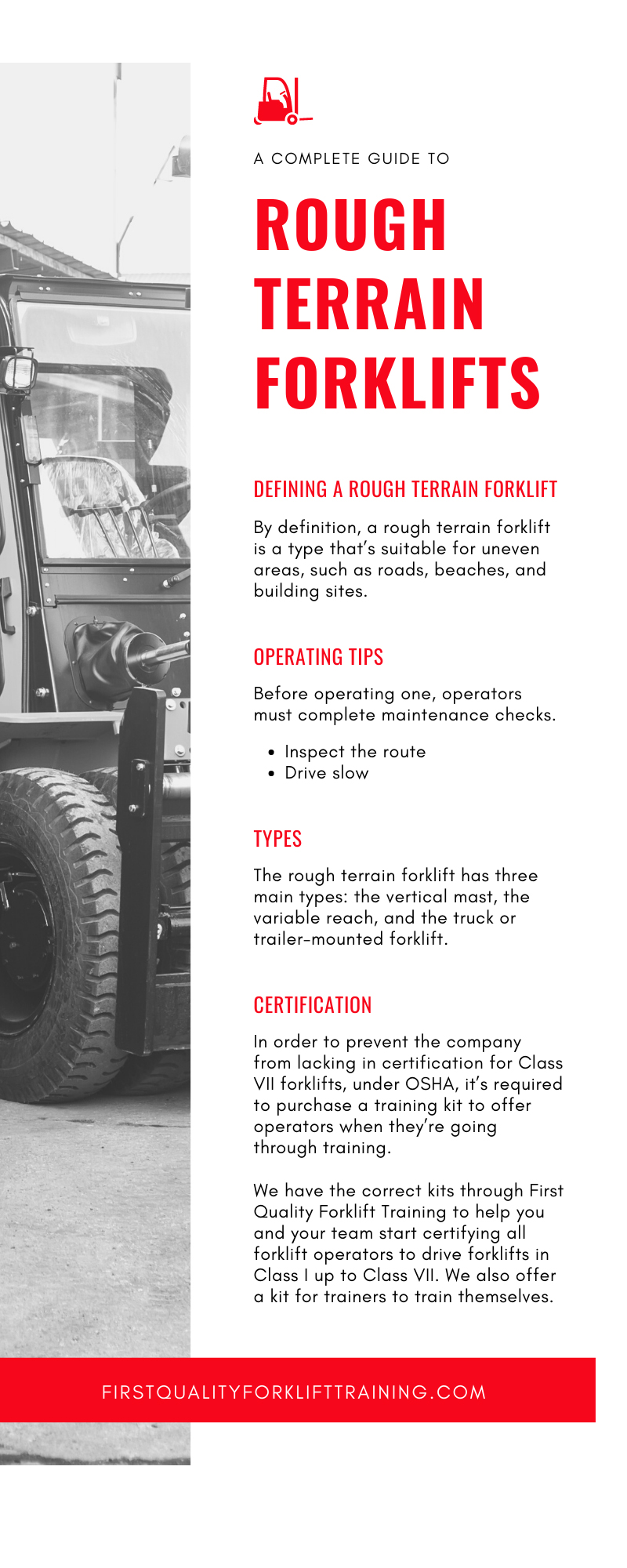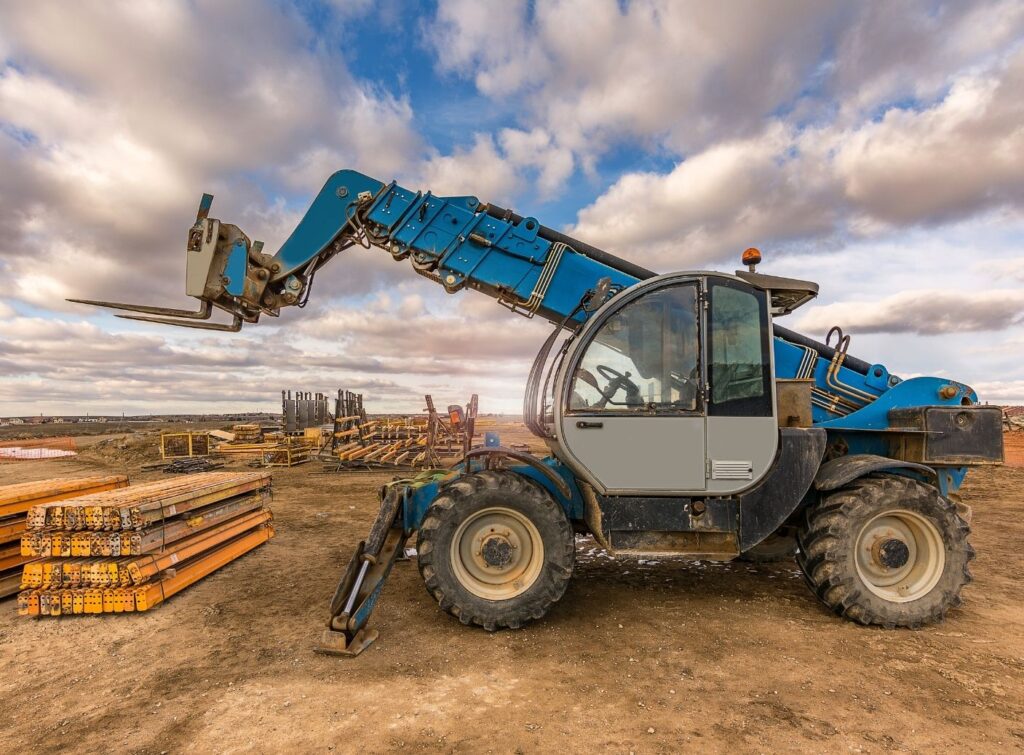Forklift Training & Certification
A Complete Guide To Rough Terrain Forklifts
The rough terrain forklift is a class VII lift that works on uneven surface areas to help carry heavy loads over rocky areas. Today, we have a complete detailed guide to rough terrain forklifts that all workers and warehouse supervisors should read and keep in mind when training new forklift operators.
Defining a Rough Terrain Forklift
By definition, a rough terrain forklift is a type that’s suitable for uneven areas, such as roads, beaches, and building sites. The rough terrain forklift goes by other names, such as the all-terrain forklift and heavy-duty lift.
Workers use these lifts to transport heavy shipments in areas such as dockyards and building sites. They can also be used on beaches when they’re getting cleaned. Although they’re used in other areas, rough terrain forklifts are often used in rural areas due to the uneven surfacing.
Furthermore, rough terrain forklifts have tires specially designed to maneuver on uneven terrain, making the lift truck safer and more functional.
Operating Tips
Operating a forklift in this class takes practice. Before operating one, operators must complete maintenance checks. Below is a list of tips for driving a rough terrain forklift that will help new operators.
Inspect the Route
Survey the route. Even though rough terrain forklifts can go over bumpy ground, workers must keep size in mind. A rough terrain forklift is one of the largest lifts in the forklift family, so encountering obstacles becomes difficult.
Inspect the path before you drive it. Walk around it to find any potential abrasive materials, obstacles, or unprepared surfaces that could negatively affect the route you’re planning to take.
Drive Slow
As your new forklift drivers become accustomed to maintenance checks, the next step in the rough terrain forklift certification process is to ensure they can drive safely.
When drivers are in training, have them practice driving slowly, as the impact of uneven ground can cause problems if they drive too fast. Driving slow and steady can make job sites safer.
This tip is especially important when certifying new operators to help them learn how to handle driving a rough terrain forklift with a load.
Types
The rough terrain forklift has three main types: the vertical mast, the variable reach, and the truck or trailer-mounted forklift. Below are more details on each type.
The Vertical Mast Forklift
The vertical mast comes equipped with large front drive tires. The two wheels in the back are used for steering the forklift and, for some models, can also be drive tires. This truck can be used for outdoor work when a forklift is being driven on uneven or natural ground.
Additionally, since these machines are larger, they can handle larger loads compared to class one, four, and five counterbalanced forklifts.
Considering its big size, the forklift requires plenty of room to operate, which is why they’re primarily used outdoors along uneven ground. As with the other two types of rough terrain forklifts, these must be driven slowly and carefully to avoid tipping.
The Variable Reach Forklift
The variable reach/telescopic boom lift is designed to not only lift a load but also reach out to place or retrieve a load. It’s specially designed for rough terrain applications.
For example, it can extend outward or retract, allowing the product to be placed/removed from inside a building or placed/removed from the roof of a building.
A Truck or Trailer Mounted Forklift
This forklift type is portable. It’s mounted on the back of a truck and can be carried to the worksite and dismounted there to unload the product right at the site, making it unnecessary for the customer to have a forklift at the construction site.
The good thing about the truck or trailer-mounted forklift is that it makes loading and unloading truckloads easier. It can also work on both natural and disturbed terrain.
However, it’s important to note that not every trailer or truck-mounted forklift is a rough terrain forklift topic covered in the rough terrain forklift operator’s certification.
Certification
As a team leader for your forklift team, you need to ensure that each operator (including yourself if you will be operating an RT forklift) has a rough terrain operator certification.
In order to prevent the company from lacking in certification for Class VII forklifts, under OSHA, it’s required to purchase a training kit to offer operators when they’re going through training.
We have the correct kits through First Quality Forklift Training to help you and your team start certifying all forklift operators to drive forklifts in Class I up to Class VII. We also offer a kit for trainers to train themselves.
Additionally, we offer a daily maintenance checklist and other training kits that review issues to be aware of. Here’s a basic layout of what to expect in one of our rough terrain certification training kits:
- Forklift stability
- Outdoor driving
- Driving at safe speeds
- How to perform maintenance checks
- How to inspect the forklift
- Jobsite inspection
- Refueling
The Issue With Not Training Employees
According to OSHA, it’s required to certify all forklift drivers who operate on rough terrain. Without the certification, businesses face dire consequences, such as penalties. One of the penalties is fining a company more than $10,000.
When the time comes to certify a rough terrain forklift operator, ensure they and the trainer receive proper training. This ensures everyone involved is safe and knowledgeable concerning the rough terrain forklift.
Common Questions
We’re here to answer questions you may have about rough terrain forklifts. Here are three commonly asked questions.
How Fast Do Rough Terrain Forklifts Go?
We don’t recommend going fast on a rough terrain forklift due to uneven ground and potential nearby safety hazards. In fact, we suggest traveling no faster than a person can walk, which means no faster than 5 mph. On average, a forklift can move up to 20 mph.
How Much Weight Does the RT Forklift Lift?
This depends on the manufacturer and the type of rough terrain lift you’re using. It varies. There are heavy-duty forklifts that can carry an excess of 55,000 pounds.
Are Heavy-Duty Forklifts Drivable Inside and Outside?
They can operate in both areas. However, these trucks find their true usefulness in outdoor applications.
While you’re exploring our complete guide to rough terrain forklifts, start considering the other kits you’d like to learn more about.
As you prepare your certification process for your workers, contact First Quality Forklift Training to help choose the best training kit for you and your team. For more information on our top-quality forklift training kits, contact us here by filling out a form.


